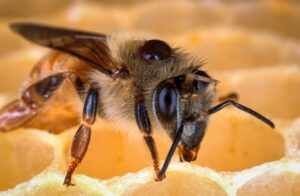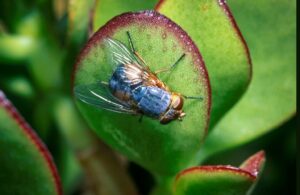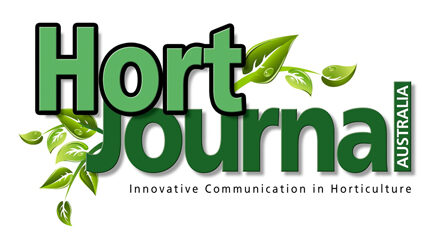
The pests that got away: Part 2
Varroa mite
By Denis Crawford
Varroa mite has spread significantly since it was detected in sentinel hives at the Port of Newcastle in June 2022. Varroa mite is likely to have a significant impact on the hives of commercial and recreational beekeepers, as well as decimate feral honey bee colonies. What will that mean for pollination in horticulture?
Varroa mites (Varroa destructor) are parasites of adult European honeybees (Apis mellifera) and their brood. Varroa mites also transmit several bee viruses. Once infested by varroa mites, a honeybee colony is likely to die if left untreated.
It has been three years (August 2022) since I last wrote about varroa mite, and it is an understatement to say the situation has changed since then. After that first detection in Newcastle, varroa spread rapidly within NSW and the ACT. Despite a 14-month long emergency response, in September 2023 it was determined that eradication of varroa mite in Australia was no longer achievable, and a transition to management was invoked.
Fast forward to September 2025 and varroa mites have been detected in South Australia, Victoria, southern Queensland, NSW and the ACT – all the eastern mainland states. The South Australian detection is an interesting one. The mites were detected at Pooginook in the Riverland region on 2 September 2025. The honeybee hives they were found in were part of a consignment from Queensland which were sourced from an area where varroa mites had not been detected. That means the outbreak in Queensland is wider than the data is currently showing.

Varroa mite detections are published in online maps –- just Google “varroa mite surveillance map” for your state. The NSW and ACT varroa mite surveillance map has been discontinued as of Tuesday 23 September 2025. The map was no longer considered representative of the extent of varroa mite across NSW and ACT. In other words, the mite had spread way beyond what the map was showing. The National Varroa Mite Management Program website states: ‘Its use has been declining in recent months anecdotally relating to a broad acceptance that varroa mite is now widespread across NSW. Additionally, varroa reports used to populate the map are also declining, meaning the level of confidence in the information displayed is low’1.
Eradication did not work, and it appears the ‘transition to management’ has enabled the spread of varroa mite rather than slowing the spread. The mites are spreading with honeybees as hives are moved around the country to pollinate certain crops. I am not laying blame here. It is now inevitable that varroa mite will spread throughout the eastern mainland states and commercial beekeepers appear to be quite sanguine about that. In fact, the Australian beekeeping industry has been preparing for the arrival of varroa mite since it became established in New Zealand twenty years ago. Varroa mite will be added to the list of things that Australian commercial beekeepers already manage.
Current approved control treatments for varroa mites in honeybee colonies in Australia include synthetic products based on flumethrin, amitraz or tau-fluvalinate; or non-synthetic products based on oxalic acid, thymol, or formic acid. Although these products help to control varroa mites they all have a negative effect on the honeybees. A new product approved by the EPA in the United States on September 25th, 2025, looks promising. It contains the active ingredient vadescana that stops the breeding cycle of varroa mites by RNA interference with no effect on honeybees2 .
Varroa mite treatments add a significant cost to a commercial beekeeping operation, but hopefully beekeepers can pass that cost on to the growers that use their pollination services. Recreational beekeepers may view the situation differently and some may find it too expensive or too difficult to manage varroa mites, and they may get out of beekeeping altogether.

Feral honeybee colonies will not be treated for varroa mites so the effect on those colonies will be devastating. The consensus view is there will be at least a 90 per cent decline in feral bee populations. We expect this to happen because that is what happened in New Zealand. Just a quick reminder, ‘feral’ honeybees are unmanaged European honeybee colonies that occur in bushland, rural areas, towns and cities. The Australian bush does not need feral honeybees, but it does need native bees which fortunately are unaffected by varroa mites. Feral (unmanaged) honeybees are often the honeybees that randomly visit gardens, parkland and rural areas providing free pollination.
Will the spread of varroa mite mean a ‘pollination crisis’? In short, no. Around about now you might be remembering statements you have seen online such as ‘bees are responsible for producing one-third of all the food we eat’. This is a myth that originates from a misrepresented line in the Pollination Handbook (1975): ‘One-third of our total diet is dependent, directly or indirectly, upon insect-pollinated plants.’
In 2007, a paper by Alex Klein and co-authors stated that ‘60% of global production comes from crops that do not depend on animal pollination, 35% from crops that depend on pollinators, and 5% are unevaluated’. The authors point out that almonds are one of the few crops that have a 100 per cent dependency on animal pollination. What animal can you move en masse to pollinate vast almond crops? Honeybees. They can be transported from far away in their hives and delivered right in among the almond trees and remain there as long as the trees are flowering. Unfortunately, this mass movement of hives is how varroa mite has spread so quickly, despite all the testing and movement permits, etc 3.

As I have said in these pages many times, bees (including native bees) are not the only pollinators. Beetles, butterflies, flies, moths, birds, and bats also pollinate flowers. Blowflies are large and hairy insects which are quite efficient pollinators. I have written here before that mango growers in Queensland are known to drag roadkill into their crops to enhance pollination by blowflies. The flies breed in the carcasses, and the adult flies feed on the nectar and pollen of the mango crops, thus pollinating them.
Another important group of flies are those in the family Syrphidae which are commonly known as hover flies or drone flies. The ones we know as hover flies (e.g. Melangyna viridiceps) serve a dual purpose; their larvae are predators of aphids, and the adult flies are pollinators. Unfortunately, the adults are not very hairy, and the pollen loads they carry are quite small when compared to honeybees, but they are pollinators, nonetheless.
A fly that is getting much attention among researchers is the common drone fly Eristalis tenax. Research has shown that it and other Eristalis species carry pollen loads comparable to the European honeybee. The common drone fly is a cosmopolitan species and is quite widespread in Australia, and we also have several species of native drone flies of the genus Eristalinus which occur throughout the country. Perhaps these flies might be mass reared and become commercially available in the future. Meanwhile naturally occurring pollinating flies can be encouraged by minimising the use of pesticides4.
The future for commercial beekeepers looks pretty good once they get through this transition period and varroa mite control becomes routine. The pollination services beekeepers provide can only increase in value. Horticultural industries that previously received free pollination from feral honeybees may have to engage commercial pollination services to replace them.
References:
- National Varroa Mite Management Program. (n.d.). National Varroa Mite Management Program. Retrieved October 7, 2025, from www.varroa.org.au
- McGruddy, R. A., et al. (2024). RNA interference as a next-generation control method for suppressing Varroa destructor reproduction in honey bee (Apis mellifera) hives. Pest Management Science, 80, 112–124.
- Klein, A. M., et al. (2007). Importance of pollinators in changing landscapes for world crops. Proceedings of the Royal Society B: Biological Sciences, 274, 303–313.
- Chisausky, J. L., et al. (2020). Syrphidae of southern Illinois: Diversity, floral associations, and preliminary assessment of their efficacy as pollinators. Biodiversity Data Journal, 8, 293–299.
Denis Crawford
E: denisjcrawford@gmail.com
